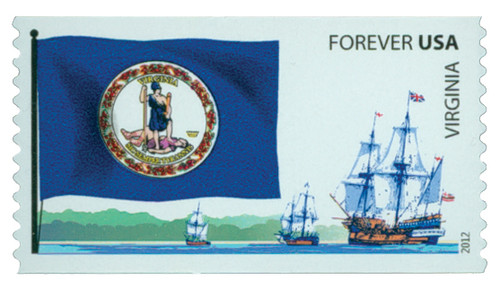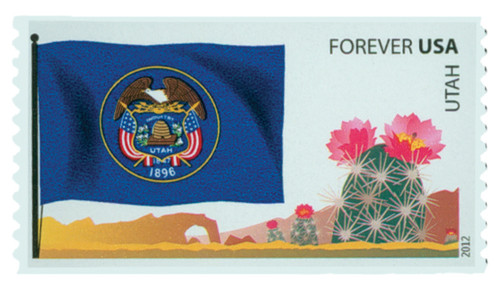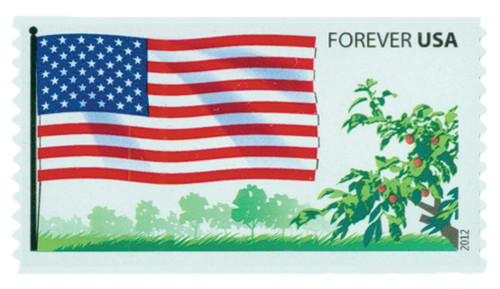
# 4327 - 2012 First-Class Forever Stamp - Flags of Our Nation: Virginia
U.S. #4327
2012 45¢ Virginia
Flags of Our Nation
Issue Date: August 16, 2012
City: Sacramento, CA
Quantity: 25,000,000
Printed By: American Packaging Corp for Sennett Security Products
Printing Method: Photogravure
Color: Multicolored
Virginia Becomes 10th State
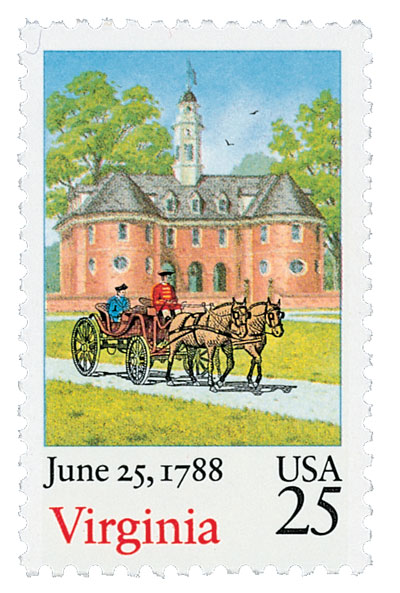
On June 25, 1788, Virginia ratified the U.S. Constitution and was admitted as the 10th state of the Union.
Several Indian tribes lived in Virginia when the first European explorers arrived. These included the Powhatan, Monacan and Manahoac, Nahyssan, Occaneechi, Susquehanna, Cherokee, and Nottoway. Spanish Jesuits created a settlement on the York River in 1570, but Indians destroyed it after just a few months.
England’s Queen Elizabeth I granted Sir Walter Raleigh permission to establish a colony in America in 1584. Raleigh sent several expeditions to the New World, but they all failed due to inadequate supplies. At that time, Raleigh and the queen gave the name Virginia to the east coast of America. In 1606, King James I chartered the Virginia Company to create a colony in Virginia. The first permanent English settlement in America was begun at Jamestown in May 1607.
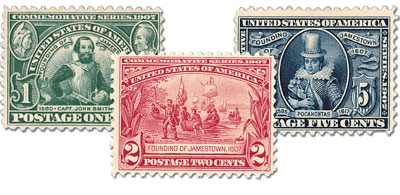
Captain John Smith led Jamestown. Smith guided the colony through many hardships until 1609, when he was injured and had to return to England. Without Smith’s leadership, the colony floundered. The following winter was called the “Starving Time,” and many colonists died of starvation. In the spring, the 60 survivors (out of 214) abandoned the settlement, but shortly after setting sail were met by supply ships led by Governor Thomas West, who was also known as Lord De La Warr. The settlers returned to Jamestown.
In 1612, colonist John Rolfe began raising tobacco. Rolfe also developed a new method for curing the tobacco leaves, and proved that tobacco could be exported to Europe. This product allowed the colony to survive economically. Rolfe married Pocahontas, the daughter of the chief of the Indian confederation around Jamestown, in 1614. This marriage brought peace between the Indians and the colonists.
Two major events occurred in Virginia in 1619. The first representative legislature in America, the House of Burgesses, was formed. The House of Burgesses met with the governor and his council to make laws for the colony. Dutch traders brought the first African slaves in America to Virginia that year as well.
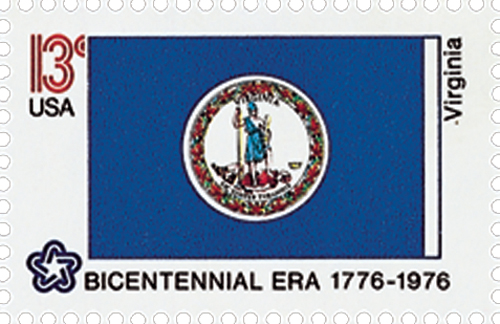
In 1624, Virginia was made a royal colony. The colony expanded westward a great deal. Over time, the colonists in eastern Virginia came to have different interests from those in the West.
Like most other colonists, Virginia’s citizens were disturbed by Britain’s policy of taxation without representation, yet most remained loyal to the king. Virginia’s leaders, Patrick Henry and Thomas Jefferson, led the colony in its dissent. When the House of Burgesses was dissolved, its members met without permission, calling themselves the First Virginia Convention. The members elected the delegates to America’s First Continental Congress. A delegate from Virginia, Peyton Randolph, became its first president. At the Second Virginia Convention, held on March 23, 1775, Patrick Henry made his famous speech, which included the words, “Give me liberty or give me death!”
In June of 1776, Virginia adopted its first Constitution and became an independent commonwealth. This constitution included a declaration of rights written by George Mason – the first bill of rights in an American constitution. In 1776, the colony submitted to the Continental Congress a resolution calling for independence. This resolution became the Declaration of Independence, written by Thomas Jefferson. Many Virginians fought for independence; in fact, more fought than in any other Southern colony. Noted leaders included the great cavalry leader “Light-Horse Harry” Lee, Daniel Morgan, and George Rogers Clark. The last major battle of the Revolutionary War was won on Virginia’s soil. In 1781, Lord Cornwallis surrendered to General Washington at Yorktown, Virginia.
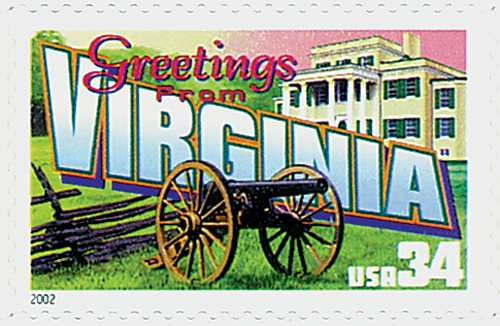
The Articles of Confederation loosely tied the 13 original colonies together. However, the Articles of Confederation soon proved to be inadequate. James Madison and other Virginians led the movement to create the Constitution of the United States. Virginia ratified the Constitution on June 25, 1788, making it the 10th state to enter the Union.
Virginia has been called the Mother of Presidents. Four of the first five U.S. Presidents were from Virginia – George Washington, Thomas Jefferson, James Madison, and James Monroe. (In total, eight U.S. Presidents have hailed from Virginia. The other four were William Henry Harrison, John Tyler, Zachary Taylor, and Woodrow Wilson.)
During the winter of 1860-61, seven Southern states withdrew from the Union. Virginia remained, hoping to find a peaceful resolution to the conflict. But, two days after Abraham Lincoln called for Virginia to supply troops to the Union on April 15, 1861, Virginia voted to secede. Richmond served as the capital of the Confederacy from May 1861 until it was captured in April 1865.
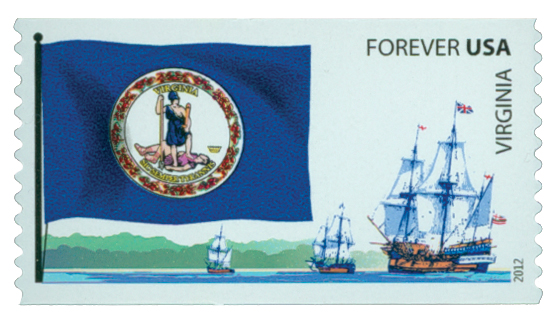
Many people from the western part of the state did not agree with the decision to secede. They set up an independent government in the northwestern portion of the state. On June 20, 1863, 48 Virginia counties became the state of West Virginia, the 35th state to join the Union. In November 1863, two more counties joined West Virginia.
Like much of the Confederacy, Virginia was devastated by the Civil War. More battles were fought there than in any other state. Virginia’s General Robert E. Lee surrendered to General Ulysses S. Grant at Appomattox Court House, Virginia, on April 9, 1865.
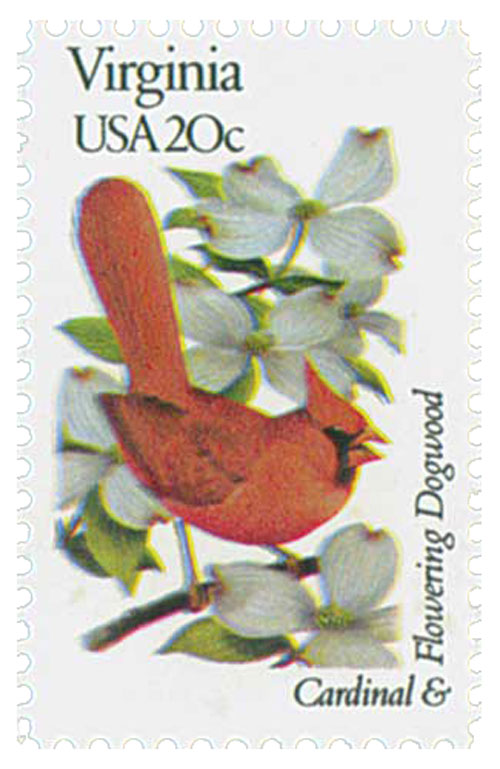
During the 1880s, while still recovering from the Civil War, Virginia began building modern industries. These included cigarette factories, cotton textile plants, and shipbuilding plants. Later, in the 1930s, many synthetic textile factories were built. World War II brought many changes to Virginia. Large numbers of people serving in the armed forces moved to Norfolk and Washington, D.C. Many of these people took permanent residence in the state after the war. During the 1960s, the manufacture of chemicals, clothing, electrical equipment, furniture, and transportation equipment increased the state’s economic strength.
Industry’s reliance on coal as a fuel source, as well as increased settlement along the Chesapeake Bay, caused a great deal of pollution in the state of Virginia. Despite this problem, Virginia has a strong economy, mainly due to its broad economic base. Manufacturing, tourism, agriculture, and the activities of the federal government keep the economy healthy.
Flags of Our Nation, Set VI: 2012 marks the sixth and final set of stamps in the series. The state and territory flags reflect the history of each region they represent. The uniqueness of each state flag in the series reflects the diversity of the United States and its territories.
The flag of Virginia has a history that began centuries before our nation’s founding. It became the state’s official flag many years later, when America was torn apart by Civil War.
In 1776, the Virginia colony declared its independence from Great Britain, and a state seal was approved the day after the nation’s Declaration of Independence was signed. The chosen symbol was taken from ancient Roman mythology and pictures the victory of the goddess Virtus (Virtue) over Tyrannis (Tyranny). Tyranny’s crown lies on the ground, representing the lost power of England’s King George III. In the king’s hands is a whip, which he had used to control and punish the colonies, along with a broken chain, indicating new-found freedom.
Though Virginia was one of the original states, it did not have an official flag until 1861. Within days of the Battle of Fort Sumter, the government of Virginia voted to secede from the Union and join the Confederate States of America. The state seal on a field of blue was soon adopted as the Virginia flag.
Regiments from Virginia carried the flag off to battle during the Civil War. The banner inspired the soldiers to continue their fight for the Confederacy.
U.S. #4327
2012 45¢ Virginia
Flags of Our Nation
Issue Date: August 16, 2012
City: Sacramento, CA
Quantity: 25,000,000
Printed By: American Packaging Corp for Sennett Security Products
Printing Method: Photogravure
Color: Multicolored
Virginia Becomes 10th State

On June 25, 1788, Virginia ratified the U.S. Constitution and was admitted as the 10th state of the Union.
Several Indian tribes lived in Virginia when the first European explorers arrived. These included the Powhatan, Monacan and Manahoac, Nahyssan, Occaneechi, Susquehanna, Cherokee, and Nottoway. Spanish Jesuits created a settlement on the York River in 1570, but Indians destroyed it after just a few months.
England’s Queen Elizabeth I granted Sir Walter Raleigh permission to establish a colony in America in 1584. Raleigh sent several expeditions to the New World, but they all failed due to inadequate supplies. At that time, Raleigh and the queen gave the name Virginia to the east coast of America. In 1606, King James I chartered the Virginia Company to create a colony in Virginia. The first permanent English settlement in America was begun at Jamestown in May 1607.

Captain John Smith led Jamestown. Smith guided the colony through many hardships until 1609, when he was injured and had to return to England. Without Smith’s leadership, the colony floundered. The following winter was called the “Starving Time,” and many colonists died of starvation. In the spring, the 60 survivors (out of 214) abandoned the settlement, but shortly after setting sail were met by supply ships led by Governor Thomas West, who was also known as Lord De La Warr. The settlers returned to Jamestown.
In 1612, colonist John Rolfe began raising tobacco. Rolfe also developed a new method for curing the tobacco leaves, and proved that tobacco could be exported to Europe. This product allowed the colony to survive economically. Rolfe married Pocahontas, the daughter of the chief of the Indian confederation around Jamestown, in 1614. This marriage brought peace between the Indians and the colonists.
Two major events occurred in Virginia in 1619. The first representative legislature in America, the House of Burgesses, was formed. The House of Burgesses met with the governor and his council to make laws for the colony. Dutch traders brought the first African slaves in America to Virginia that year as well.

In 1624, Virginia was made a royal colony. The colony expanded westward a great deal. Over time, the colonists in eastern Virginia came to have different interests from those in the West.
Like most other colonists, Virginia’s citizens were disturbed by Britain’s policy of taxation without representation, yet most remained loyal to the king. Virginia’s leaders, Patrick Henry and Thomas Jefferson, led the colony in its dissent. When the House of Burgesses was dissolved, its members met without permission, calling themselves the First Virginia Convention. The members elected the delegates to America’s First Continental Congress. A delegate from Virginia, Peyton Randolph, became its first president. At the Second Virginia Convention, held on March 23, 1775, Patrick Henry made his famous speech, which included the words, “Give me liberty or give me death!”
In June of 1776, Virginia adopted its first Constitution and became an independent commonwealth. This constitution included a declaration of rights written by George Mason – the first bill of rights in an American constitution. In 1776, the colony submitted to the Continental Congress a resolution calling for independence. This resolution became the Declaration of Independence, written by Thomas Jefferson. Many Virginians fought for independence; in fact, more fought than in any other Southern colony. Noted leaders included the great cavalry leader “Light-Horse Harry” Lee, Daniel Morgan, and George Rogers Clark. The last major battle of the Revolutionary War was won on Virginia’s soil. In 1781, Lord Cornwallis surrendered to General Washington at Yorktown, Virginia.

The Articles of Confederation loosely tied the 13 original colonies together. However, the Articles of Confederation soon proved to be inadequate. James Madison and other Virginians led the movement to create the Constitution of the United States. Virginia ratified the Constitution on June 25, 1788, making it the 10th state to enter the Union.
Virginia has been called the Mother of Presidents. Four of the first five U.S. Presidents were from Virginia – George Washington, Thomas Jefferson, James Madison, and James Monroe. (In total, eight U.S. Presidents have hailed from Virginia. The other four were William Henry Harrison, John Tyler, Zachary Taylor, and Woodrow Wilson.)
During the winter of 1860-61, seven Southern states withdrew from the Union. Virginia remained, hoping to find a peaceful resolution to the conflict. But, two days after Abraham Lincoln called for Virginia to supply troops to the Union on April 15, 1861, Virginia voted to secede. Richmond served as the capital of the Confederacy from May 1861 until it was captured in April 1865.

Many people from the western part of the state did not agree with the decision to secede. They set up an independent government in the northwestern portion of the state. On June 20, 1863, 48 Virginia counties became the state of West Virginia, the 35th state to join the Union. In November 1863, two more counties joined West Virginia.
Like much of the Confederacy, Virginia was devastated by the Civil War. More battles were fought there than in any other state. Virginia’s General Robert E. Lee surrendered to General Ulysses S. Grant at Appomattox Court House, Virginia, on April 9, 1865.

During the 1880s, while still recovering from the Civil War, Virginia began building modern industries. These included cigarette factories, cotton textile plants, and shipbuilding plants. Later, in the 1930s, many synthetic textile factories were built. World War II brought many changes to Virginia. Large numbers of people serving in the armed forces moved to Norfolk and Washington, D.C. Many of these people took permanent residence in the state after the war. During the 1960s, the manufacture of chemicals, clothing, electrical equipment, furniture, and transportation equipment increased the state’s economic strength.
Industry’s reliance on coal as a fuel source, as well as increased settlement along the Chesapeake Bay, caused a great deal of pollution in the state of Virginia. Despite this problem, Virginia has a strong economy, mainly due to its broad economic base. Manufacturing, tourism, agriculture, and the activities of the federal government keep the economy healthy.
Flags of Our Nation, Set VI: 2012 marks the sixth and final set of stamps in the series. The state and territory flags reflect the history of each region they represent. The uniqueness of each state flag in the series reflects the diversity of the United States and its territories.
The flag of Virginia has a history that began centuries before our nation’s founding. It became the state’s official flag many years later, when America was torn apart by Civil War.
In 1776, the Virginia colony declared its independence from Great Britain, and a state seal was approved the day after the nation’s Declaration of Independence was signed. The chosen symbol was taken from ancient Roman mythology and pictures the victory of the goddess Virtus (Virtue) over Tyrannis (Tyranny). Tyranny’s crown lies on the ground, representing the lost power of England’s King George III. In the king’s hands is a whip, which he had used to control and punish the colonies, along with a broken chain, indicating new-found freedom.
Though Virginia was one of the original states, it did not have an official flag until 1861. Within days of the Battle of Fort Sumter, the government of Virginia voted to secede from the Union and join the Confederate States of America. The state seal on a field of blue was soon adopted as the Virginia flag.
Regiments from Virginia carried the flag off to battle during the Civil War. The banner inspired the soldiers to continue their fight for the Confederacy.

